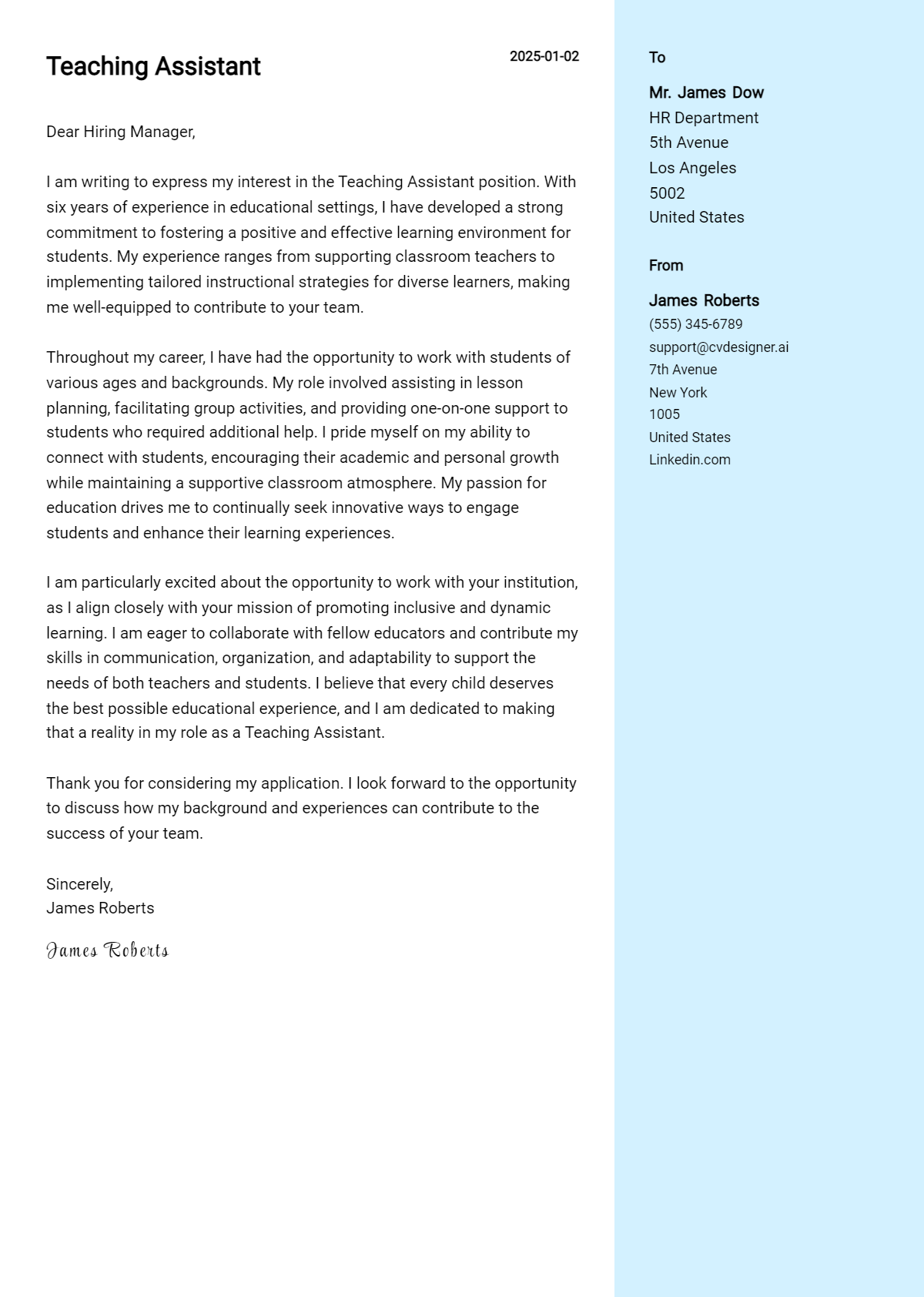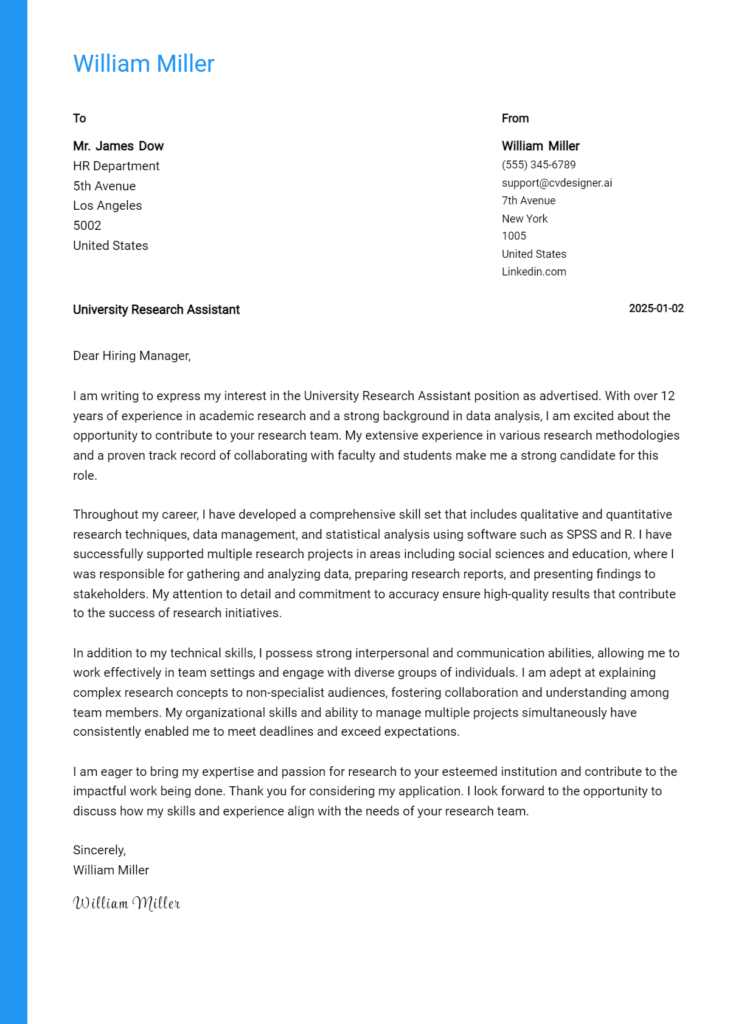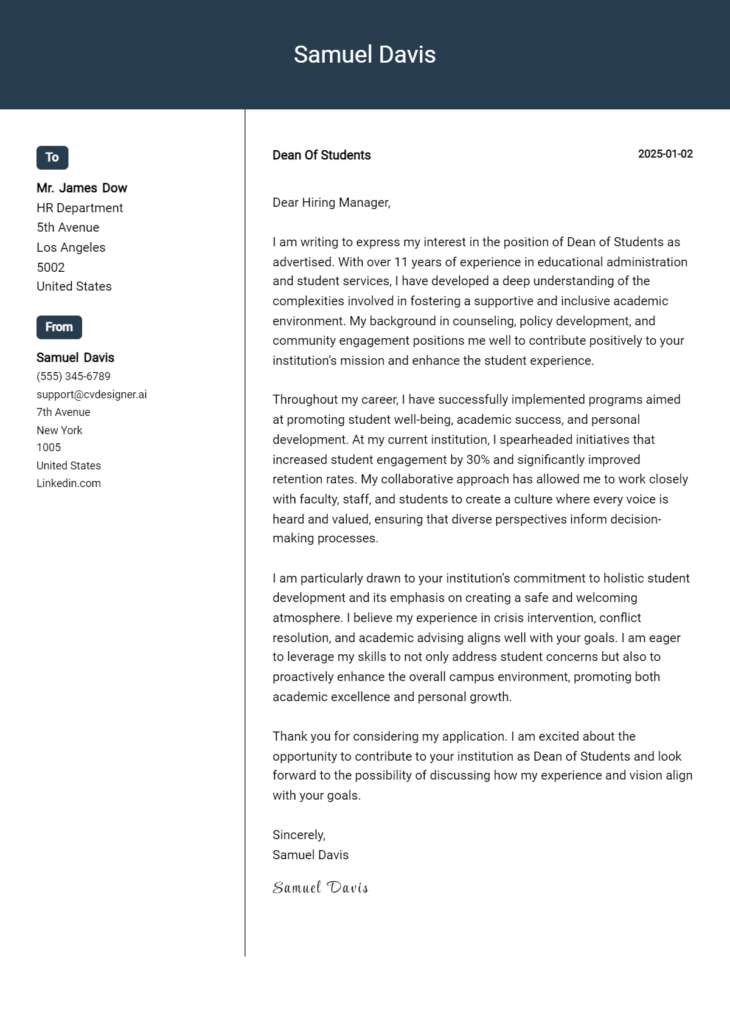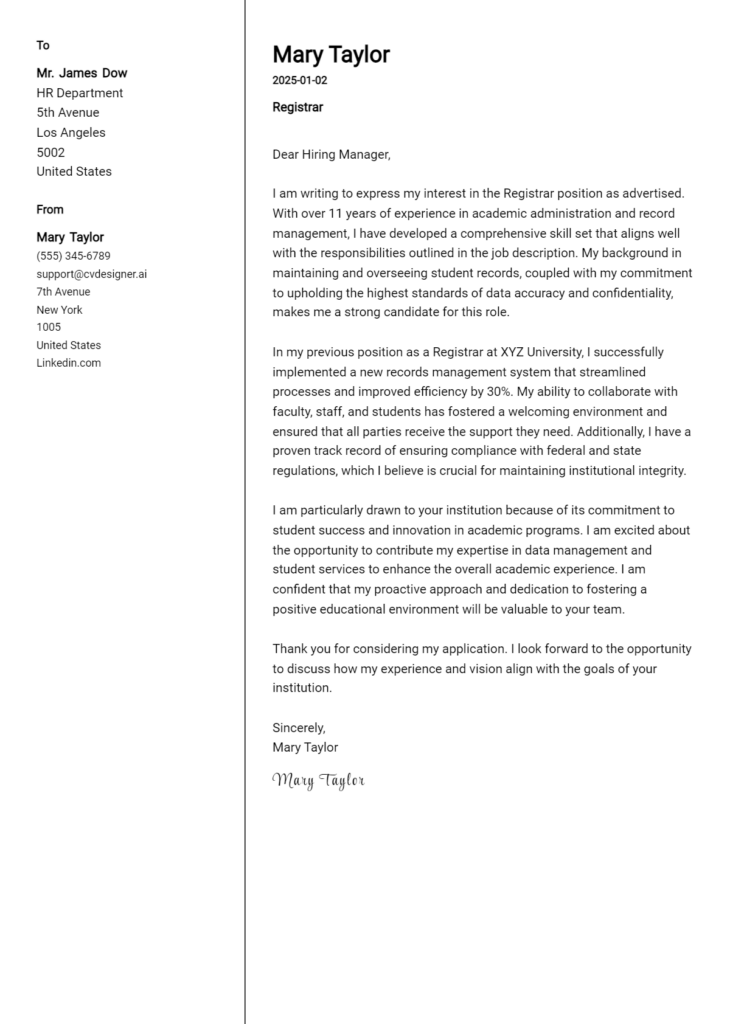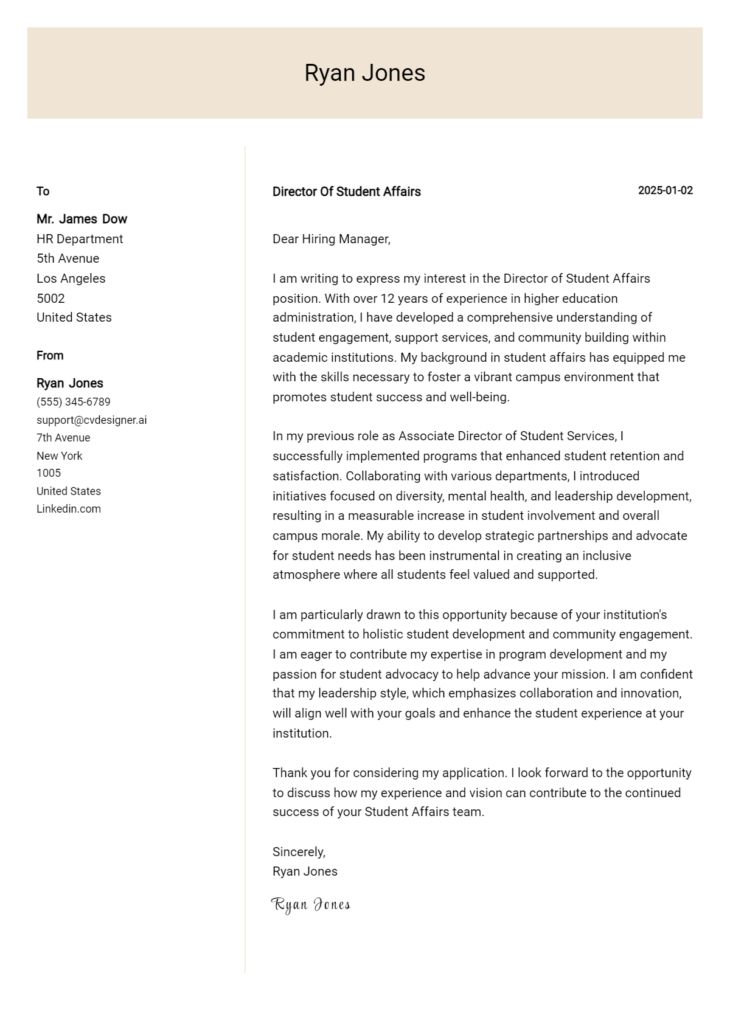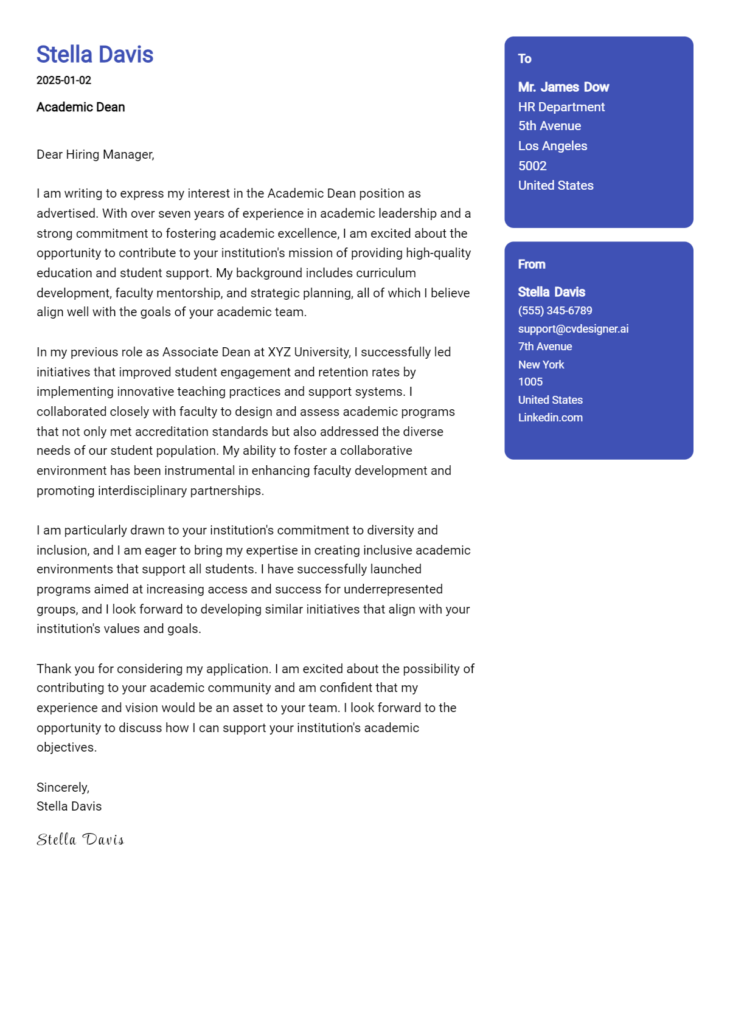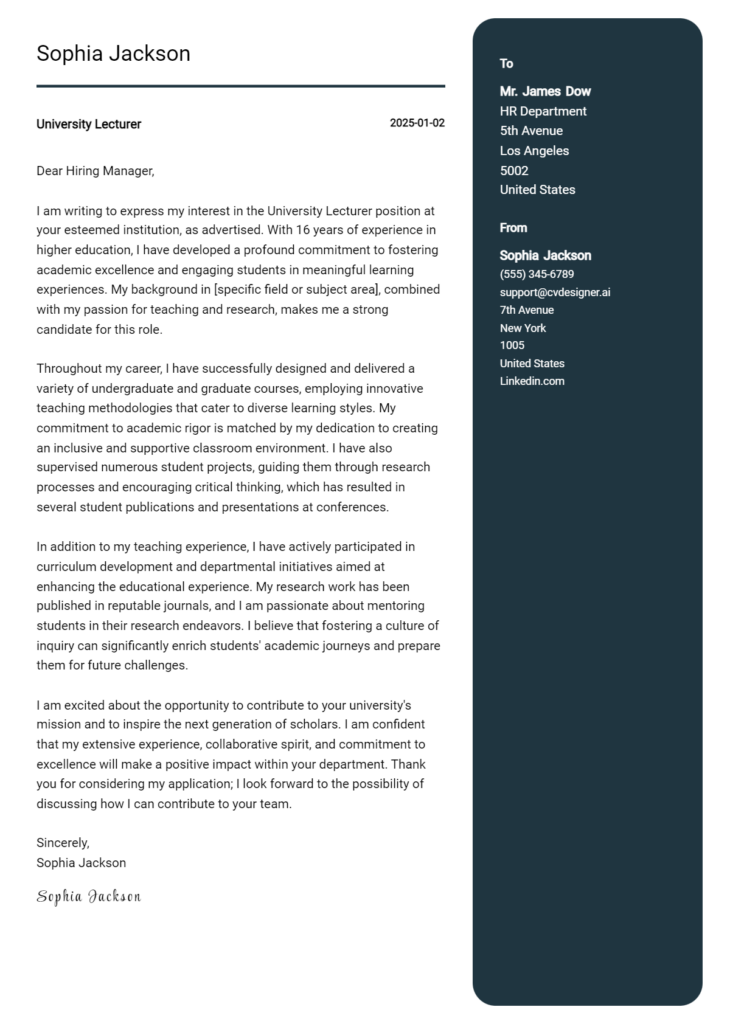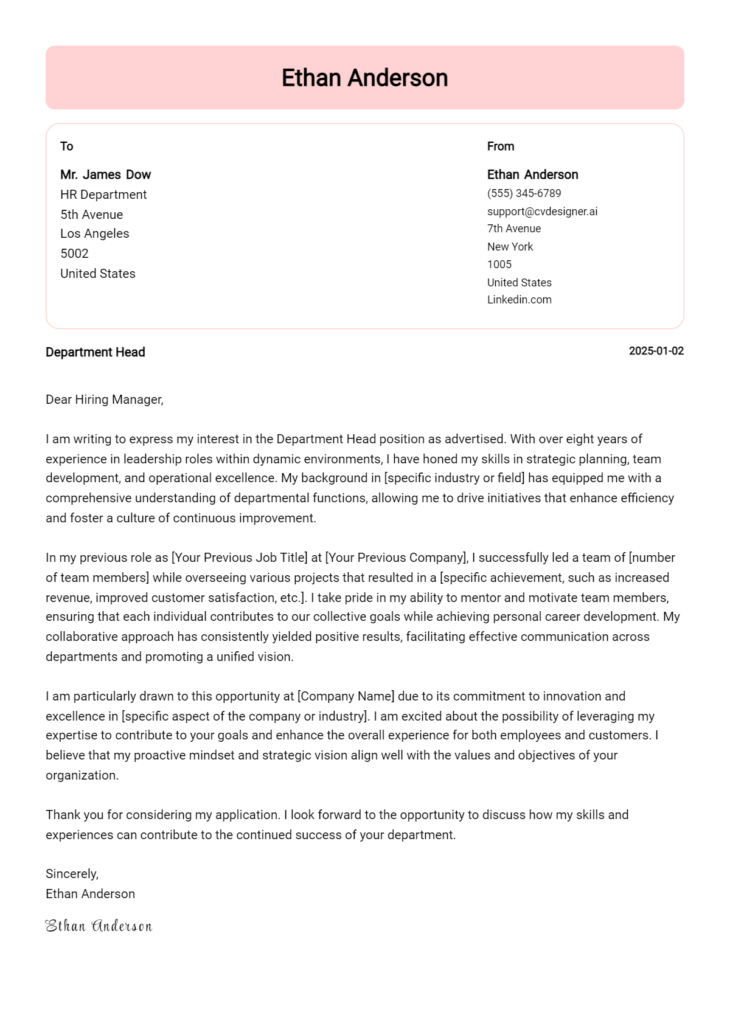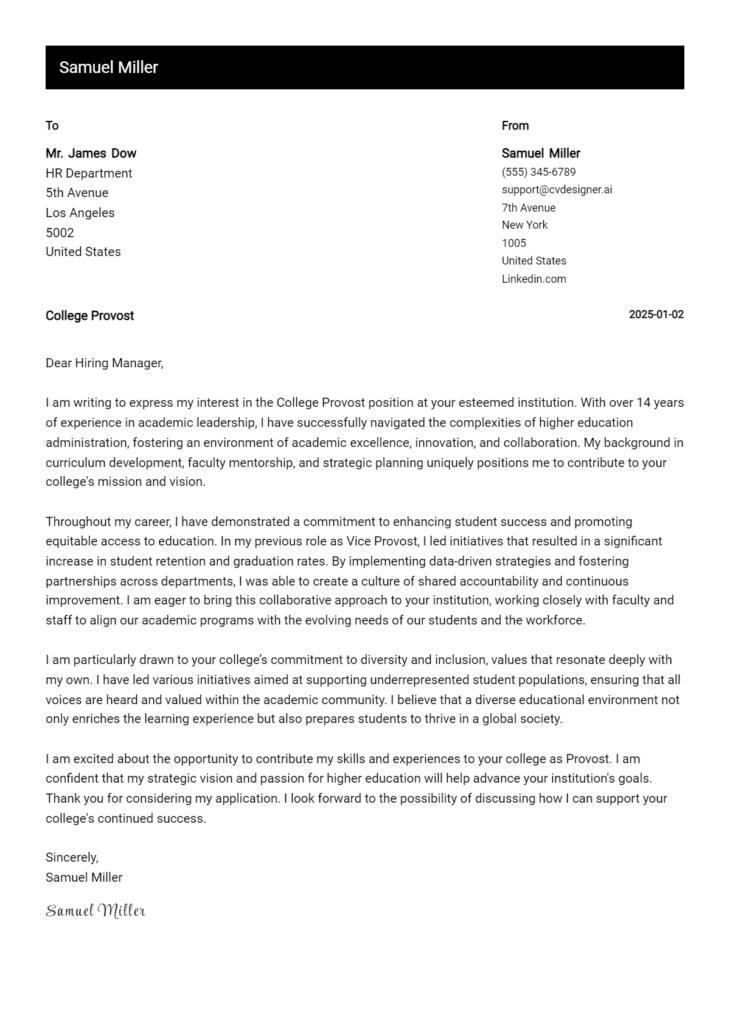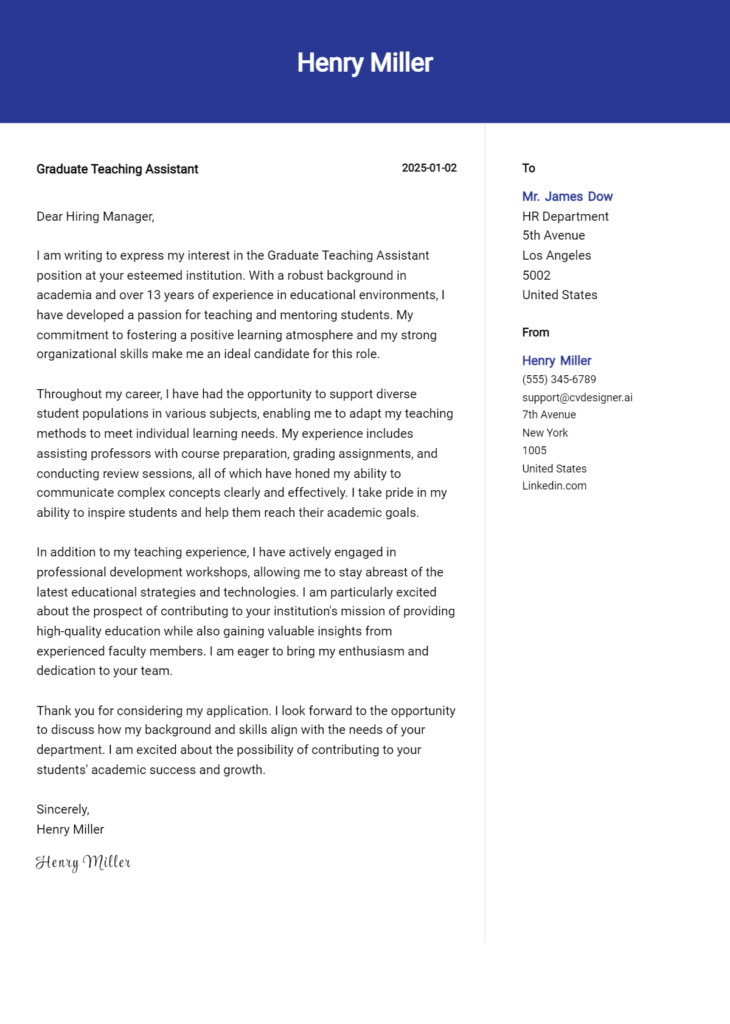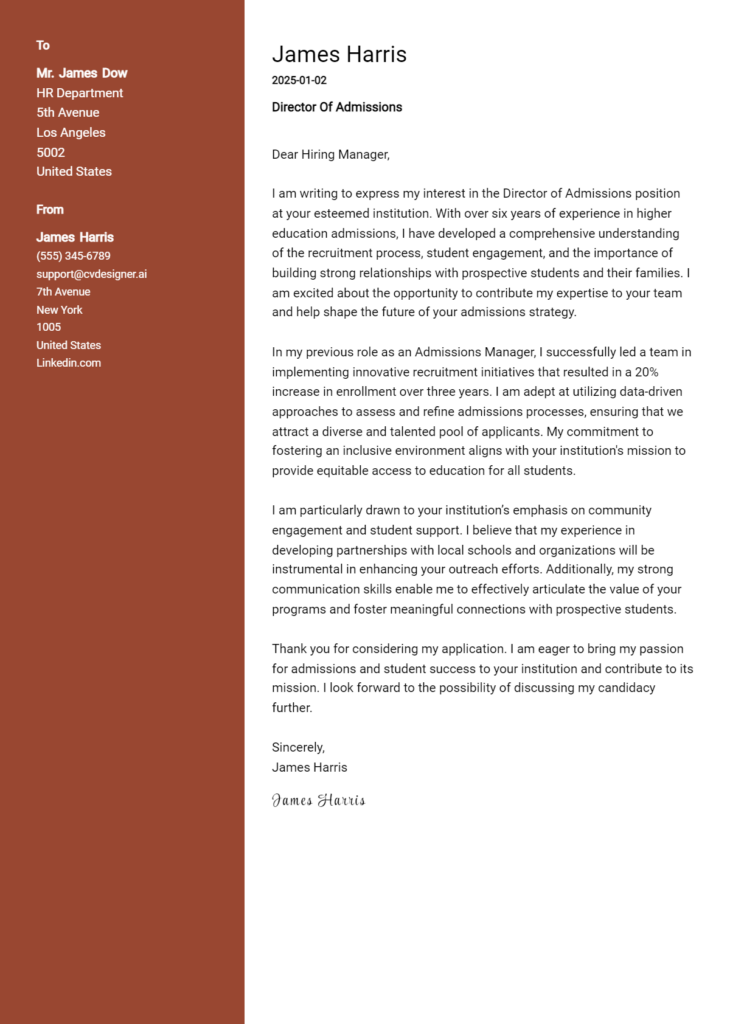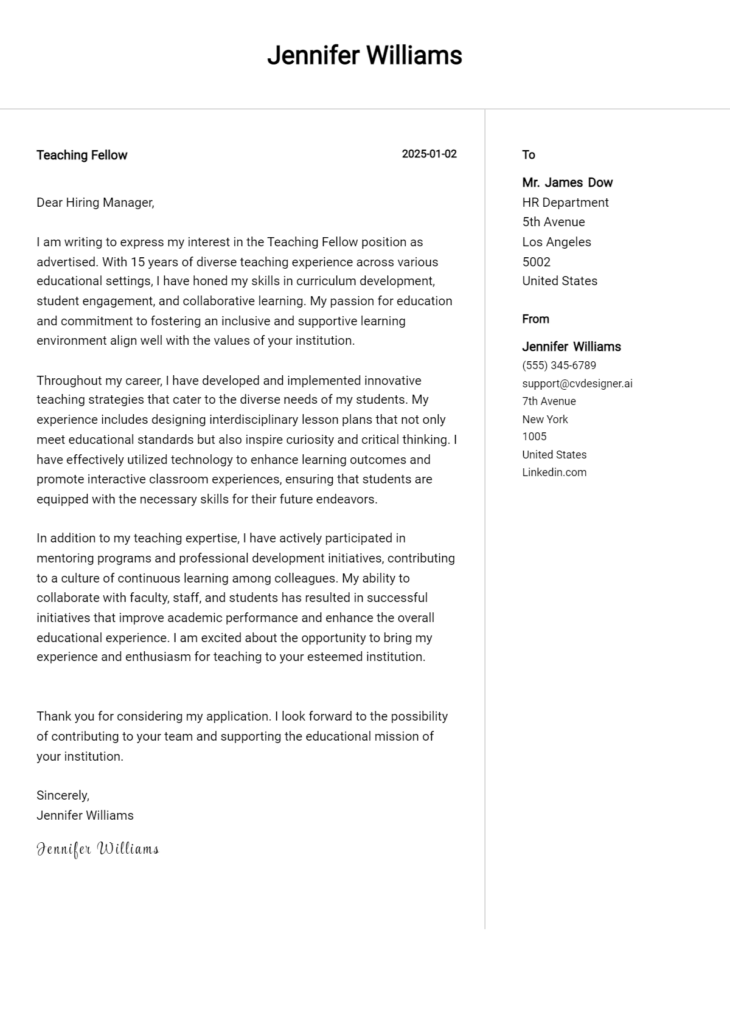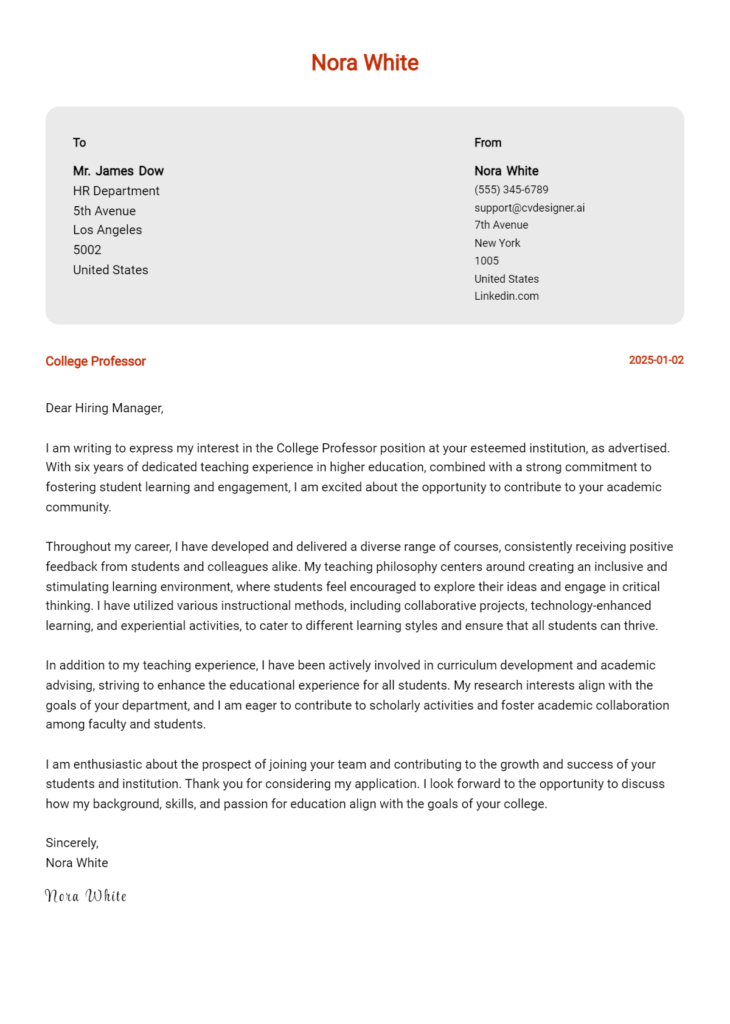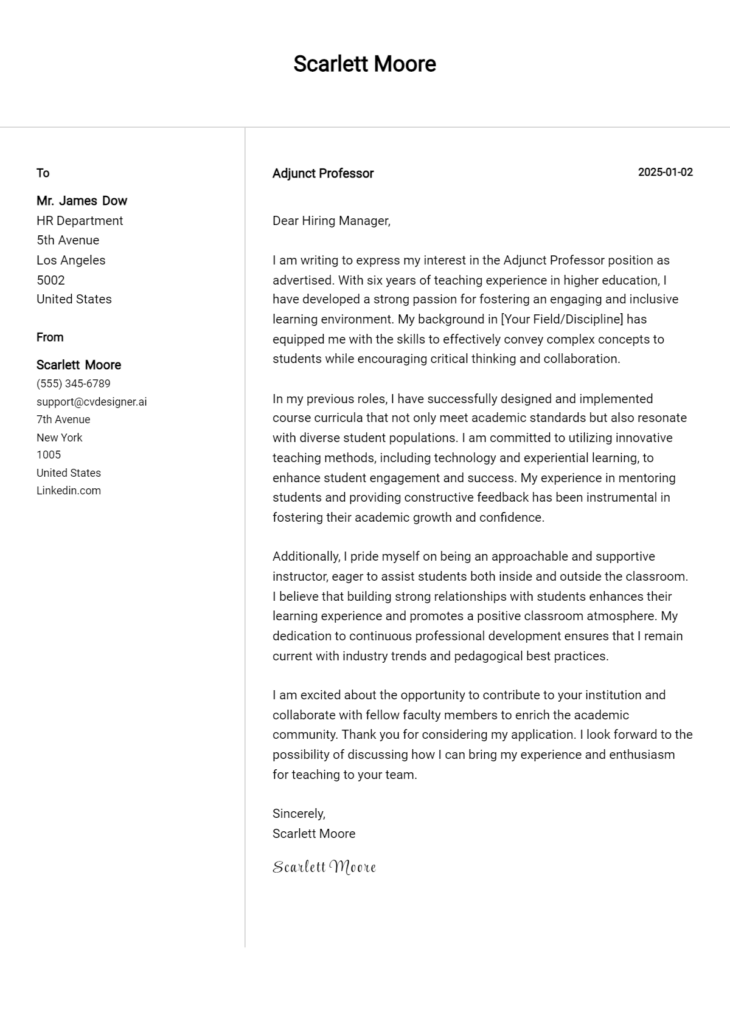Teaching Assistant Cover Letter Examples
Explore additional Teaching Assistant cover letter samples and guides and see what works for your level of experience or role.
How to Format a Teaching Assistant Cover Letter?
Crafting a well-structured cover letter is essential for aspiring Teaching Assistants, as it not only showcases your qualifications but also reflects your communication skills and dedication to education. The format of your cover letter can significantly impact a hiring manager's first impression, highlighting your organizational abilities and professionalism—traits that are vital in a teaching environment.
In this guide, we'll explore how to effectively structure your Teaching Assistant cover letter, providing valuable insights and examples that cater specifically to the education sector.
We'll focus on the key components of a professional cover letter, including:
- Cover Letter Header
- Cover Letter Greeting
- Cover Letter Introduction
- Cover Letter Body
- Cover Letter Closing
Each section is crucial in demonstrating your enthusiasm for the role and your suitability for the position. Let’s delve into each part and discover how to make your Teaching Assistant cover letter truly stand out.
Importance of the Cover Letter Header for a Teaching Assistant
The header of a cover letter is a critical component that sets the tone for the entire application. It serves as the first point of contact between the applicant and the hiring committee, making clarity and professionalism essential. A well-structured header should include your contact information, the date, and the recipient’s details, ensuring that all necessary information is easily accessible. This not only showcases your attention to detail but also enhances the overall presentation of your application.
A strong header reflects your organizational skills and respect for the recipient’s time, while a weak header can create confusion and diminish the impact of your application.
Strong Example:
Jane Doe 123 Education Lane Cityville, ST 12345 jane.doe@email.com (123) 456-7890 October 15, 2023 Mr. John Smith Hiring Committee ABC School 456 Learning Way Townsville, ST 67890
Weak Example:
jane doe email: jane.doe@email.com 10/15/23 Mr. John Smith ABC School
The Importance of the Cover Letter Greeting
The greeting of a cover letter plays a crucial role in setting the tone for the rest of the letter. It is the first impression a hiring manager receives, and a well-crafted greeting demonstrates professionalism and respect for the recipient. By addressing the hiring manager directly, you personalize your application and show that you have taken the time to research who will be reading your letter. Avoiding generic greetings not only makes your application stand out but also reflects your genuine interest in the position. If you are unsure of the recipient's name, it is worth the effort to look it up, as a personalized approach can significantly enhance your chances of making a positive impression.
Strong Greeting Example
Dear Mr. Smith,
Weak Greeting Example
To Whom It May Concern,
The Importance of a Well-Crafted Cover Letter Introduction for a Teaching Assistant
A well-crafted cover letter introduction is crucial for a Teaching Assistant position as it serves as the first impression to the hiring manager. An engaging introduction not only captures attention but also expresses genuine interest in the role while highlighting key skills or achievements that make the candidate a suitable fit. This initial paragraph sets the tone for the rest of the letter and can significantly influence the hiring manager's decision to read further. Below are examples of strong and weak cover letter introductions that illustrate this point effectively.
Strong Example
Dear Hiring Manager, I am excited to apply for the Teaching Assistant position at XYZ School, as I believe my passion for education and my experience working with diverse student populations make me a perfect candidate. With a Bachelor's degree in Education and over two years of hands-on experience in classroom support, I have honed my ability to create engaging learning environments that foster student growth and collaboration. I am eager to bring my skills in curriculum support and individualized instruction to your esteemed institution.
Weak Example
To whom it may concern, I am writing to apply for the Teaching Assistant job. I have some experience and think I would be okay at it. I like working with kids, and I hope to get this job.
Purpose of the Cover Letter Body for a Teaching Assistant
The body of a cover letter for a Teaching Assistant position serves as a critical platform for candidates to showcase their relevant skills, experiences, and the value they can bring to the educational environment. This section should highlight specific projects or accomplishments that demonstrate the candidate's ability to support teachers and engage with students effectively. By detailing their contributions in past roles, candidates can illustrate their suitability for the position and their potential impact on student success. This is an opportunity to connect personal experiences with the needs of the school, making a compelling case for why the candidate is an ideal fit.
Strong Example
In my previous role as a Teaching Assistant at Lincoln Middle School, I successfully implemented a peer tutoring program that improved students' mathematics scores by an average of 15% over one semester. I collaborated closely with teachers to identify students who would benefit from additional support and created tailored lesson plans that addressed their specific needs. Additionally, my experience organizing classroom activities and managing small groups during lessons has honed my ability to foster a positive learning environment, ensuring that all students feel engaged and supported.
Weak Example
I have worked with children before and I think I would be a good fit for this job. I have helped in my cousin's classroom and I know how to keep kids quiet. I can help the teacher with some tasks and I am willing to learn more about being a Teaching Assistant.
Importance of the Cover Letter Closing for a Teaching Assistant
The closing paragraph of a cover letter is a crucial component, as it serves to summarize the applicant's qualifications, reiterate their enthusiasm for the role, and prompt the hiring manager to take the next steps in the hiring process. A strong closing can leave a lasting impression and encourage the reader to review the attached resume or schedule an interview, while a weak closing may fail to convey the applicant's eagerness or competence.
Strong Example
Thank you for considering my application for the Teaching Assistant position. With my background in education and my passion for supporting student learning, I am excited about the opportunity to contribute to your team. I am eager to discuss how my skills and experiences align with the needs of your classroom. I look forward to the possibility of discussing my application further and am available for an interview at your earliest convenience.
Weak Example
I hope you look at my resume. I want to be a Teaching Assistant, but I'm not sure if I'm the right fit. Please let me know what you think.
These tips will help candidates craft an effective cover letter for a Teaching Assistant position, emphasizing the importance of showcasing relevant skills and experiences. A well-crafted cover letter not only highlights your qualifications but also reflects your passion for education and your commitment to fostering a collaborative learning environment. By demonstrating your technical skills, problem-solving abilities, understanding of the Software Development Life Cycle (SDLC), teamwork, and dedication to continuous learning, you can create a compelling narrative that resonates with hiring committees.
Tips for Writing Your Teaching Assistant Cover Letter
Highlight Your Technical Skills
Begin with a clear statement of your technical skills relevant to the role. If you have experience with educational technology, software tools, or programming languages, make sure to mention them. Demonstrating proficiency in these areas shows that you are capable of supporting both teachers and students effectively. Utilize cover letter templates to find formats that emphasize your skills.Showcase Problem-Solving Abilities
Provide examples of how you have successfully tackled challenges in previous roles, whether in educational settings or otherwise. Describe specific situations where your problem-solving skills led to positive outcomes. This not only illustrates your capability but also reflects your proactive approach to potential classroom challenges.Discuss Your Knowledge of the SDLC
If applicable, discuss your understanding of the Software Development Life Cycle (SDLC) and how it relates to educational technologies. This knowledge can be particularly valuable in tech-focused educational environments. Show how you can contribute to the planning and implementation of educational software solutions that enhance the learning experience.Emphasize Teamwork and Collaboration
Education is a collaborative effort, and your ability to work well in teams is crucial. Share experiences where you collaborated with educators, parents, or peers to achieve common goals. Highlight your communication skills and your ability to foster a supportive environment for students.Express a Passion for Continuous Learning
Convey your commitment to lifelong learning and professional development. Mention any relevant courses, workshops, or certifications you have pursued to enhance your skills. This not only demonstrates your initiative but also aligns with the educational values of growth and improvement.
For additional assistance, consider using a cover letter builder to streamline the process and ensure your cover letter is polished and professional.
Common Mistakes to Avoid in a Teaching Assistant Cover Letter
Avoiding common mistakes in your Teaching Assistant cover letter is crucial for making a positive impression on potential employers. A well-crafted cover letter can set you apart from other candidates, so it’s vital to steer clear of pitfalls that could undermine your application. Here are some frequent errors and tips on how to avoid them:
Generic Greeting: Using a generic salutation like "To Whom It May Concern" can make your letter seem impersonal. Instead, research the hiring manager’s name and address them directly.
Repetition of Resume: Simply reiterating what’s in your resume can bore readers. Instead, use your cover letter to highlight specific experiences and skills that align with the Teaching Assistant role.
Lack of Focus: A cover letter that wanders off-topic can confuse the reader. Stay focused on your motivation for applying and how your background makes you a suitable candidate.
Ignoring the Job Description: Failing to tailor your cover letter to the job description can lead to missed opportunities. Analyze the job listing and incorporate relevant keywords and qualifications.
Spelling and Grammar Errors: Typos and grammatical mistakes can signal a lack of attention to detail. Always proofread your cover letter multiple times, or consider using a tool to check for errors.
Overly Formal or Casual Tone: Striking the right balance in tone is essential. Aim for a professional yet approachable voice that reflects your personality while remaining respectful.
Failure to Showcase Passion: A lack of enthusiasm for the role can be a dealbreaker. Convey your passion for education and helping students succeed to make your application stand out.
For more guidance, you can explore various cover letter examples and learn about the best cover letter format.
Cover Letter FAQs for Teaching Assistant
What should I include in my cover letter for a Teaching Assistant position?
In your cover letter for a Teaching Assistant position, you should include your relevant educational background, any previous teaching or tutoring experience, and specific skills that make you a strong candidate. Highlight your ability to support teachers and engage with students, as well as your understanding of classroom dynamics. Mention any relevant certifications or training, such as First Aid or Child Development courses. Additionally, include a brief anecdote or example that demonstrates your passion for education and your commitment to fostering a positive learning environment. Tailor your cover letter to reflect the specific school or institution you are applying to, showing that you’ve researched their values and mission.
How can I make my cover letter stand out?
To make your cover letter stand out, focus on showcasing your unique qualities and experiences that align with the Teaching Assistant role. Use a compelling opening statement to grab the reader's attention, and personalize your letter by addressing it to the hiring manager, if possible. Incorporate specific examples of your past experiences, such as successful student interactions or collaboration with teachers, to illustrate your skills. Use clear and concise language, and avoid generic phrases that could apply to any position. Finally, express genuine enthusiasm for the opportunity and how your goals align with the school's mission, making it clear why you are an excellent fit for their team.
How long should my cover letter be?
Your cover letter should ideally be one page long, consisting of three to four paragraphs. Aim for a length of about 250 to 400 words. This length allows you to provide enough detail about your qualifications and experiences without overwhelming the reader. Be concise and focused; each sentence should serve a purpose. Start with a strong introduction, followed by a paragraph that outlines your relevant experiences and skills. Conclude with a summary of your eagerness to contribute to the school and a call to action, such as expressing your desire for an interview. Keeping your cover letter succinct ensures that it captures the attention of hiring managers while providing essential information.
Should I tailor my cover letter for each application?
Absolutely! Tailoring your cover letter for each application is crucial in demonstrating your genuine interest in the specific Teaching Assistant position and school. Customization allows you to highlight the experiences and skills that are most relevant to the job description. Start by carefully reading the job listing to identify key qualifications and qualities the school is looking for. Then, align your experiences with those requirements, using specific examples that showcase how you meet their needs. Additionally, referencing the school's values or programs can show that you've done your homework and are committed to contributing to their community. Personalized cover letters make a stronger impression and increase your chances of landing an interview.
Build your Cover Letter in minutes
Use an AI-powered cover letter builder and have your letter done in 5 minutes. Just select your template and our software will guide you through the process.

